Welcome to Moebius Nature Center’s self-guided nature trail.
You may follow the trail “live” at the Nature Center or “virtually” by the information and videos below. The half-mile trail takes you through three ecosystems: forest, meadow, and pond. Along the trail are nine stations each one marked by an informational sign. Some of the stations have a video (available by a QR code live, or by a link for the virtual visitor). We plan to add age-related questions or observations at each station to assist local teachers and parents in guiding their students through science curricula defined by local elementary and middle schools.
You may also follow The Misadventures of Beverly Beaver as she follows the Nature Trail. This is a delightful story about beavers. Just click on the “misadventure links” throughout this page.
The Misadventures of Beverly Beaver, Chapter 1 Children’s Version Older Children/Adult’s Version
Buckeye Grove
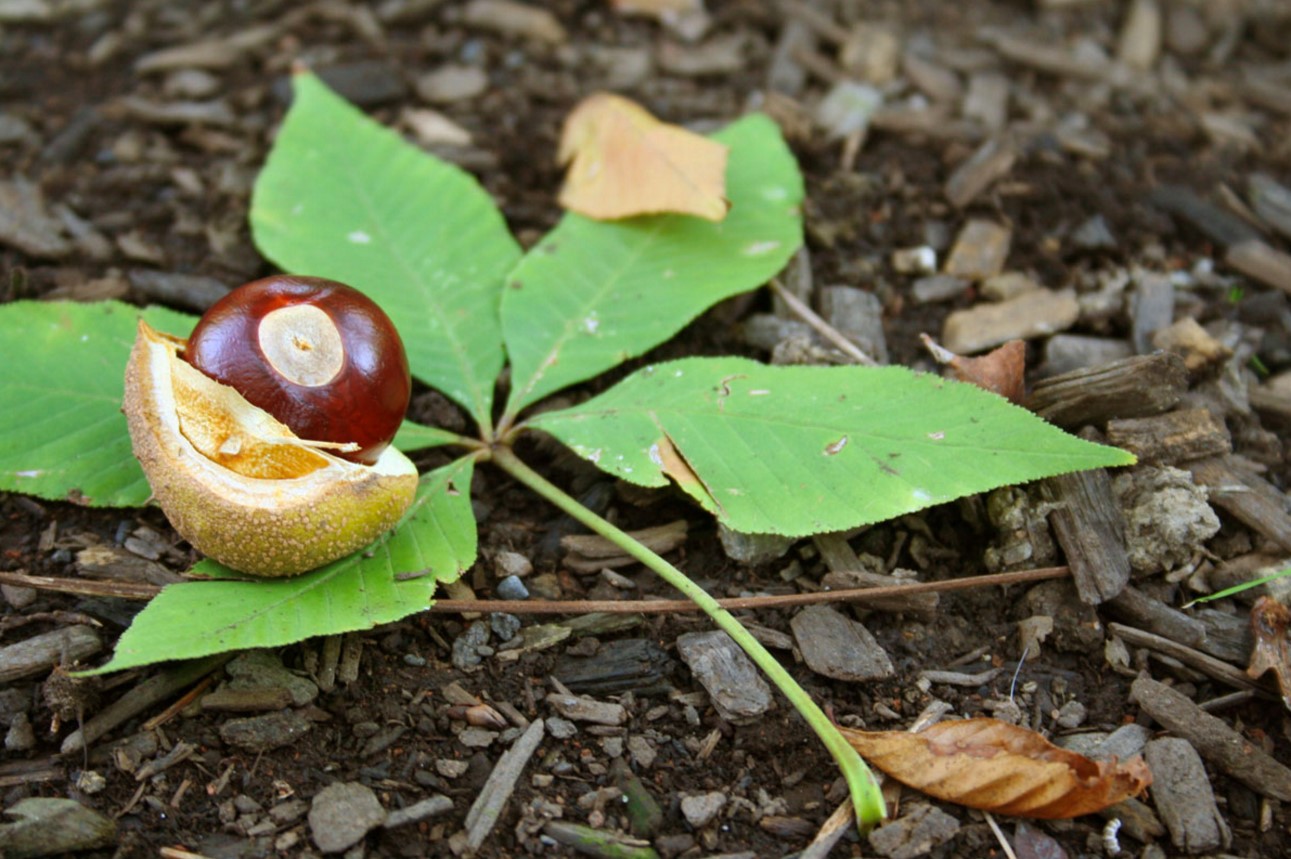
Biodiversity
Why is Biodiversity Important? –
In the pond ecosystem, when there are many different plants in the surrounding habitats there are more varieties of insects; with more insects there will be more fish and invertebrate animals. If one species of plant or insect dies, there is always a “back-up” to keep the ecosystem healthy. When different plants and animals depend upon one another for their survival, it is called “inter-dependence”.
In the meadow ecosystem, a single native plant such as Penstemon may be pollinated by as many as five different insects and birds. This helps ensure that the plant will survive for many generations, while offering nectar and food for the pollinators.
All over the world, ecosystems are becoming less and less diverse with destruction of habitats. This lack of diversity means there is less back-up when one species dies or disappears from the ecosystem. Not only does this threaten survival of humans but it can also spell ecological disaster for large regions of the world. Video.
The Misadventures of Beverly Beaver, Chapter 2 Children’s Version Older Children/Adult’s Version
Buckthorn
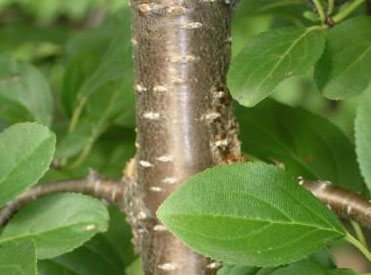 Invasive plants such as buckthorn reproduce rapidly, spread over large areas, and have few if any natural controls. They crowd out native plants resulting in less variety of plants that cover the forest floor. That means fewer wildflowers, fewer pollinators, fewer nesting sites and ultimately a slow death to the forest as new generations of trees fail to thrive. Video.
Invasive plants such as buckthorn reproduce rapidly, spread over large areas, and have few if any natural controls. They crowd out native plants resulting in less variety of plants that cover the forest floor. That means fewer wildflowers, fewer pollinators, fewer nesting sites and ultimately a slow death to the forest as new generations of trees fail to thrive. Video.
If you would like to help us remove invasive plants from areas around our nature center, please contact Kim@mymnc.org.
Forest Ecosystem

Forests are not simply individual trees, but are active communities closely tied together, which allows for their long-term survival. Stands of trees offer food and shelter for hundreds of species of insects, birds, and mammals. The trees and animals depend on each other in order to survive.
Rotting dead trees attract a multitude of insects, such as Longhorn beetles and many types of fungi that decompose the wood. Fungi can spread underground connecting the roots of one tree to another. Through these fungal webs, nutrients, as well as chemicals that fight diseases, can pass from one tree to another, keeping the weaker trees healthy.
The seasonally wet areas in our forests (vernal pools) are also important in the breeding cycles of local amphibians such as Spring Peeper frogs and Spotted salamanders.
The greater the diversity of insects and birds in the forest, the more tree and wildflower seeds are dispersed. This helps to sustain the life cycles of the forest and to maintain its stability and health. Video.
The Misadventures of Beverly Beaver, Chapters 3 and 4 Children’s Version Older Children/Adult’s Version
Meadow Ecosystem
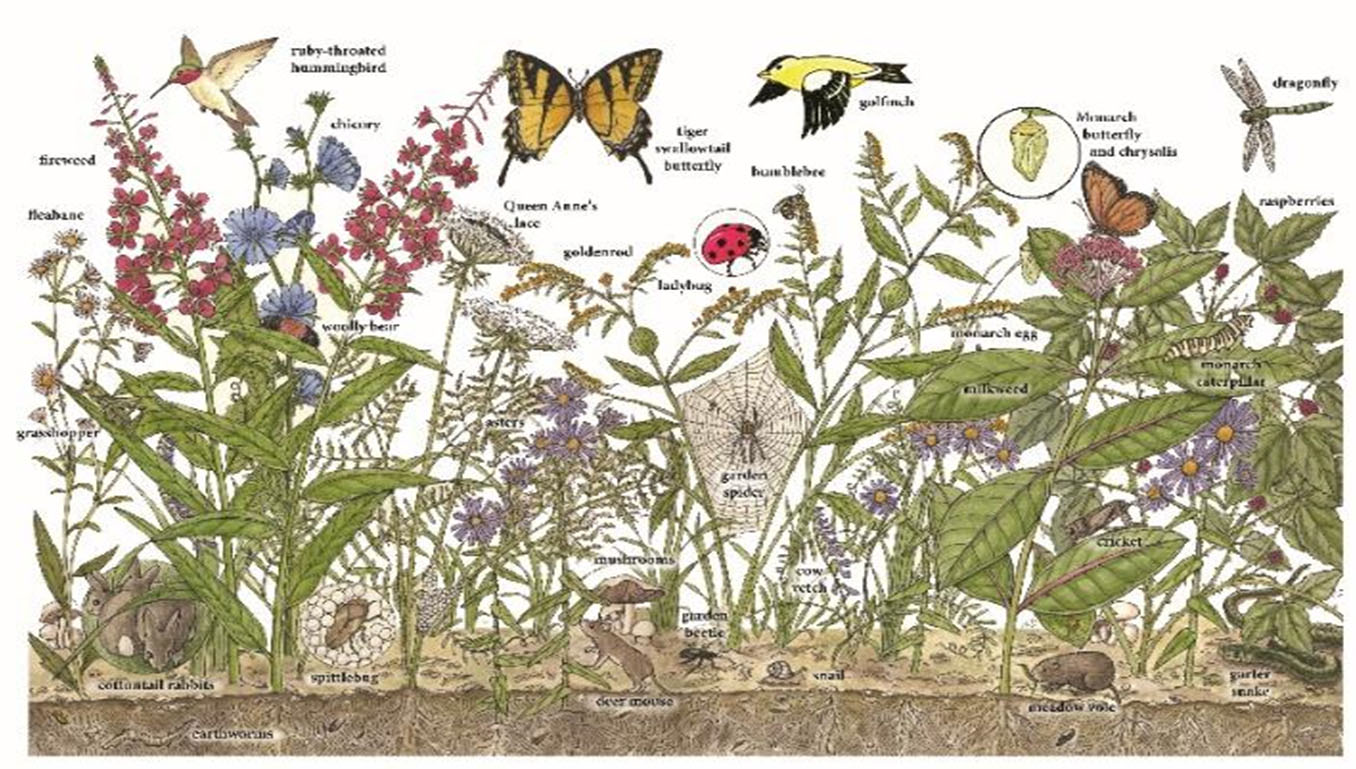 Used with permission from sheri@exploringnature.org
Used with permission from sheri@exploringnature.org
Meadows are among the most biodiverse ecosystems in North America. They are often the first ecosystem to grow and develop in the open clearings created by human or nature’s activities.
Hundreds of species of plants, insects, birds and other animals depend upon meadows for food, reproduction, and shelter.
Our meadow is also a wetland (thanks to the beavers!). It provides an extra diversity of plants (cattails), insects (Blue Dasher dragonflies, Tiger Swallowtail butterflies), birds (goldfinches, Red-winged blackbirds), amphibians (American toads, Northern Leopard frogs) reptiles (Garter snakes), invertebrates (snails, slugs), and mammals (Deer mice and Meadow voles).
Native wildflowers in the meadow, such as goldenrod, asters, and Queen Anne’s Lace, attract a multitude of pollinators (bees, wasps, butterflies, hummingbirds, and beetles). The diversity of these pollinators helps to ensure the ongoing survival of the flowers while providing valuable nectar to the pollinators—especially in late summer and fall.
This diversity in Ohio’s meadow ecosystems is threatened by the invasive species of plants, such as garlic mustard and multiflora rose. Video.
The Misadventures of Beverly Beaver, Chapters 5 and 6 Children’s Version Older Children/Adult’s Version
Beaver Lodge
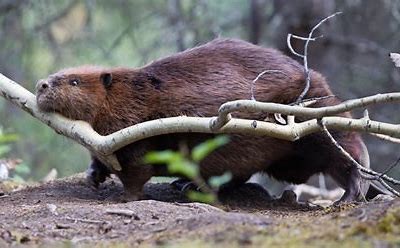 Beavers live in structures called lodges. Our beavers have built two lodges here on our pond—one on each side of the pond. Some lodges are built in the center of ponds; ours are bank lodges on the shore. These allow them to occasionally burrow into the soft mud on the edges of the pond. Beavers’ teeth are orange due to the iron in the teeth. They never stop growing, so beavers need to constantly chew on wood to keep them from getting too long.
Beavers live in structures called lodges. Our beavers have built two lodges here on our pond—one on each side of the pond. Some lodges are built in the center of ponds; ours are bank lodges on the shore. These allow them to occasionally burrow into the soft mud on the edges of the pond. Beavers’ teeth are orange due to the iron in the teeth. They never stop growing, so beavers need to constantly chew on wood to keep them from getting too long.
The lodges are constructed of both branches (e.g. willow and ash), grass, and mud. Inside the lodge there are one or two shelves above the water level where the beavers live, store food, and raise their young kits.
Most lodges will house a male, female, and one or two generations of kits.
The dam at the far end of the pond is constantly tended to keep the water level in the pond just right for them to be protected both in the open water and while in their lodge. Along the north shore of the pond you can see small, trampled trails leading from the shore into the meadow on to the woodland beyond. At night theythe beavers will search for saplings to bring to their lodge for both construction and food. Video.
The Misadventures of Beverly Beaver, Chapter 7 Children’s Version Older Children/Adult’s Version
Pond Ecosystem I
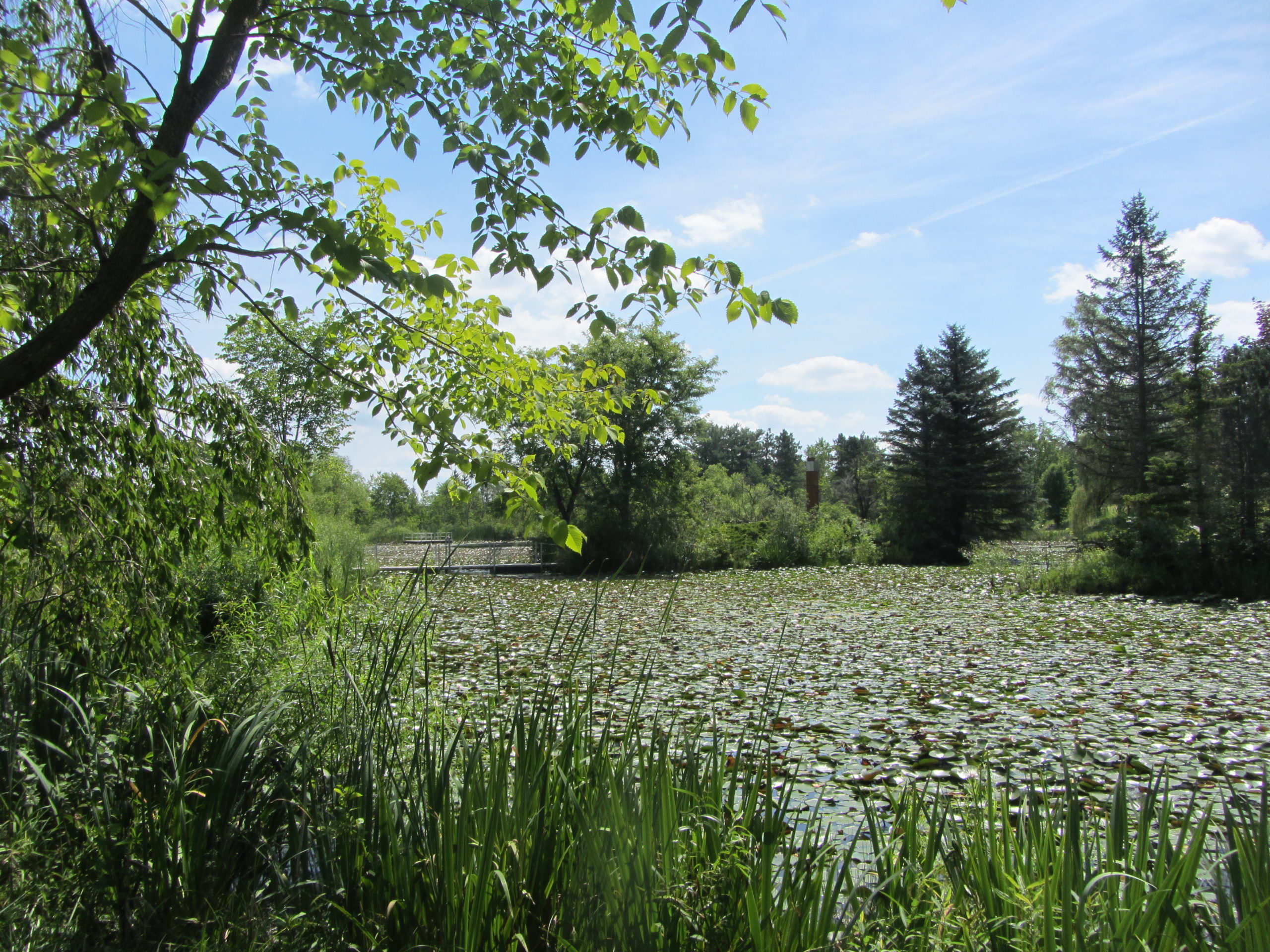 Our pond is a complex ecosystem with four different habitats, or places where animals and plants live: (1) pond surface life, (2) shoreline, (3) underwater habitats, and (4) life on the bottom. Most of this is due to the beavers. Beavers are considered a “keystone” species because if you took them out of the ecosystem, it could eventually collapse.
Our pond is a complex ecosystem with four different habitats, or places where animals and plants live: (1) pond surface life, (2) shoreline, (3) underwater habitats, and (4) life on the bottom. Most of this is due to the beavers. Beavers are considered a “keystone” species because if you took them out of the ecosystem, it could eventually collapse.
By building dams from branches and mud these animal “engineers” keep the pond deep enough to allow the flow of water below the ice in Winter. In that way they can have protection and food while raising their young (kits). The pond allows plants and insects to thrive. It provides food for animals and places to lay their eggs, raise their young, and hibernate.
Some of the animals in our pond include amphibians (Spring peepers, Green and American Bullfrogs, Eastern Spotted newts), reptiles (Snapping and Midland Painted turtles, Northern Water snakes), Fish (Bluegill, Sunfish, Bass), and waterfowl (Mallard ducks, Canada geese). Video.
Beaver Dam
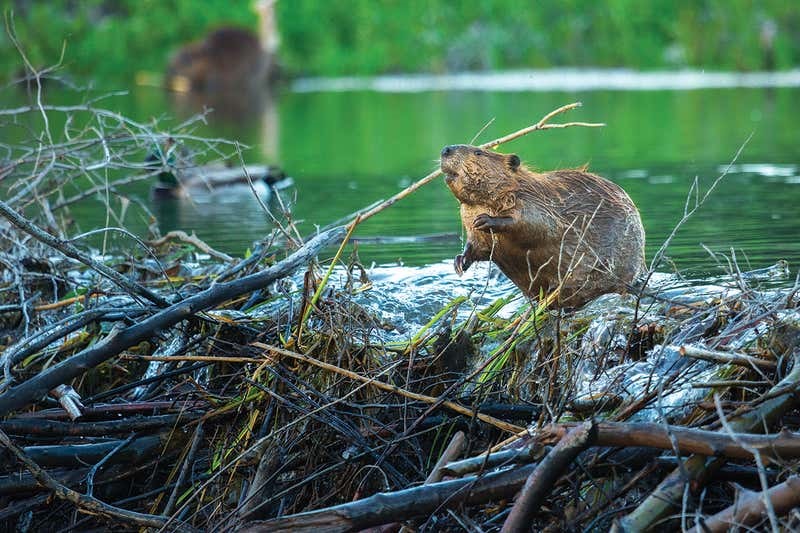 Beavers build dams along streams, resulting in ponds like you see here at Moebius Nature Center. These ponds in turn offer protection against local predators, such as coyotes; allow a safe location for their lodges; and, provide easy access to food during winter. The dams modify the natural environment to create the overall pond ecosystem. Beavers work at night and are prolific builders, carrying mud and stones with their fore-paws and timber between their teeth.
Beavers build dams along streams, resulting in ponds like you see here at Moebius Nature Center. These ponds in turn offer protection against local predators, such as coyotes; allow a safe location for their lodges; and, provide easy access to food during winter. The dams modify the natural environment to create the overall pond ecosystem. Beavers work at night and are prolific builders, carrying mud and stones with their fore-paws and timber between their teeth.
A minimum water level of 2-3 feet is required to keep the underwater entrance to their lodge from being blocked by ice during the winter.
Beavers start construction by diverting the stream to lessen the water flow. Branches and logs are then driven into the mud of the stream bed to form a base. Then sticks, bark, rocks, mud, grass, leaves, masses of plants, and anything else available, are used to build the superstructure.
Beavers vary the type of dam built and how they build it, according to the speed of water on the stream. In slow-moving water, they build a straight dam, whereas in fast-moving water they tend to be curved. Dam-building is especially active in the fall.
Pond Ecosystem II
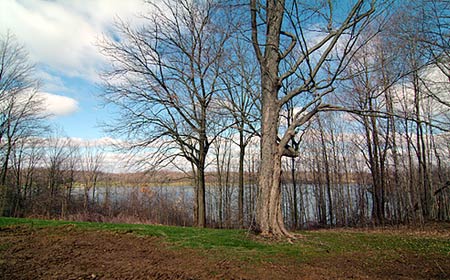 Our pond (pictured left covered with lily pads) is a good example of a healthy and stable ecosystem. Both living and non-living things interact with each other providing an environment that supports many different species of plants and animals. There are four habitats within our pond ecosystem: (1) pond surface life, (2) shoreline, (3) underwater habitats, and (4) life on the bottom. Many of the plants and animals in these habitats depend on each other for survival. Plants and algae in the pond are eaten by microscopic animals (zooplankton), which are eaten by tadpoles, frogs and fish. Many insects hatch in the pond providing food for birds and dragonflies. The frogs, snakes, and turtles depend upon shore plants and lily pads for protection. Our beavers helped create the pond with their dam, allowing a greater variety of plants and animals to survive.
Our pond (pictured left covered with lily pads) is a good example of a healthy and stable ecosystem. Both living and non-living things interact with each other providing an environment that supports many different species of plants and animals. There are four habitats within our pond ecosystem: (1) pond surface life, (2) shoreline, (3) underwater habitats, and (4) life on the bottom. Many of the plants and animals in these habitats depend on each other for survival. Plants and algae in the pond are eaten by microscopic animals (zooplankton), which are eaten by tadpoles, frogs and fish. Many insects hatch in the pond providing food for birds and dragonflies. The frogs, snakes, and turtles depend upon shore plants and lily pads for protection. Our beavers helped create the pond with their dam, allowing a greater variety of plants and animals to survive.
The Misadventures of Beverly Beaver, complete story Children’s Version Older Children/Adult’s Version
